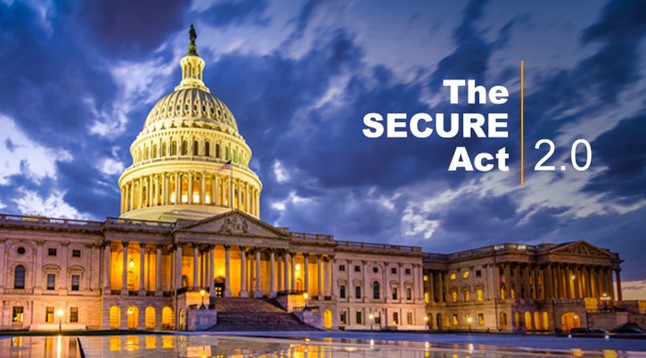As we glide into the back half of 2023, the financial landscape will be evolving once again with the implementation of provisions from the SECURE 2.0 Act. Building on the foundation of the SECURE Act of 2019, this legislation aims to enhance retirement-savings opportunities and pave the way for more secure retirements. With 92 new provisions designed to expand retirement plan coverage and boost individual retirement savings, the SECURE 2.0 Act holds the potential to reshape the way we prepare for our golden years.

Some of the 92 provisions went into effect on January 1, 2023, but other provisions go live in 2024 and beyond. Below we take a closer look at those 2024 provisions and how you may be able to capitalize on them.
- Required Minimum Distributions (RMDs) for Roth Plans (Section 325): A significant change in the SECURE 2.0 Act is the elimination of RMDs for qualified employer Roth plan accounts. This move provides retirees with greater flexibility in managing their retirement savings, allowing them to keep their funds invested for longer periods.
- Emergency Expense Distributions (Section 115): To address unforeseen financial needs, the Act introduces the concept of “emergency” distributions. Individuals can withdraw up to $1,000 from their retirement account without facing the usual 10% additional early withdrawal tax. However, failing to repay this distribution within a specific timeframe restricts further emergency withdrawals for three years.
- Penalty-free withdrawal for domestic abuse instances (Section 314): Individuals who experience domestic abuse may withdraw the lesser of $10,000 (indexed for inflation), or 50% of the account value. This withdrawal, like the “emergency” distribution, will not be subject to the 10% additional early withdrawal tax. Any repayment that occurs to the retirement plan over 3 years, taxes will be refunded for the amount.
- 401(k) Higher Catch-Up Limits (Section 109): Individuals aged 50 or older can ALREADY take advantage of increased contribution limits for retirement plans by taking advantage of the $7,500 catch-up contribution. For those aged 60, 61, 62, or 63, the catch-up limitation is increasing to $10,000 for most plans ($5,000 for SIMPLE plans) enhancing the opportunity for older worker’s to save for retirement.
- Indexing IRA Catch-Up Limit (Section 108): Catch-Up contributions for IRAs will be subject to annual inflation adjustments, instead of a flat $1,000.
- Highly Compensated Employee Catch-Up Limitations (Section 603): Eligible workers with incomes over $145,000 will no longer be able to make their catch-up contribution (age 50+) on a pre-tax basis. This will eliminate additional tax deductions in the year contributed. If the worker decided to utilize the catch-up, they will have to contribute on a post-tax basis (roth). Here is a recent blog post written on Financial Friction that digs deeper into the “Rothification” of Catch-up
*Keep in mind, there are discussions about if this was a drafting error, so unless corrected by Congress, this rule will hold true for 2024 until future correction occurs. - Employer Fund Match for Student Loan Payments (Section 110): Since the recent denial of the Supreme Court ruling on student loan forgiveness, perhaps employees have another option a little closer to home. Beginning 2024, your employer can make a “matching contribution” to your retirement plan account based on your student loan payment amount. This provision is designed to address the fact that high student loan debt can keep people from saving for retirement.
- Roth Rollover Option for 529 Plans (Section 126): In select cases, individuals maintaining a 529 plan for at least 15 years can roll over the funds to a Roth IRA, subject to specific limitations. There will be a $35,000 lifetime limit on what can be rolled to the Roth IRA from the 529.
- Employer Force Out (Section 304): Employers will be able to force the balance of a former employee out of a retirement plan and into an IRA if the balance is below $7,000 (current limit is $5,000). This could create difficulties for those employees who forget about old accounts. *On the bright side, by the end of 2023 there should be a lost-and-found database established by the US Labor Department.
- Emergency Savings Accounts (Section 127): Employers will be able to automatically enroll non-highly compensated employees in emergency savings accounts, contributing up to 3% of gross wages (capped at $2,500 per year). These contributions are matched by employers and can be withdrawn tax-free for emergency needs. Contributions are made on a Roth basis and four distributions per year can be taken.
- Additional Employer Contribution for SIMPLE IRAs (Section 116): Employers sponsoring SIMPLE IRAs have the option to make an additional employer contribution to each employee in a uniform manner of up to 10% of employee wages, capped at $5,000.
- Starter 401(k) Plans for Employers (Section 121): Small businesses without retirement plans can offer starter 401(k) plans or safe harbor 403(b) plans, allowing employees to save for retirement with default enrollment.
The SECURE 2.0 Act marks a transformative step forward in retirement planning, offering individuals and employers a myriad of innovative options to enhance financial security during retirement. With provisions designed to ease student loan burdens, streamline contribution processes, and increase the flexibility of retirement accounts, the 2.0 Act fosters a more comprehensive and adaptable approach to retirement planning. By capitalizing on these changes and staying informed about the evolving financial landscape, individuals can position themselves for a brighter, more golden financial future.
